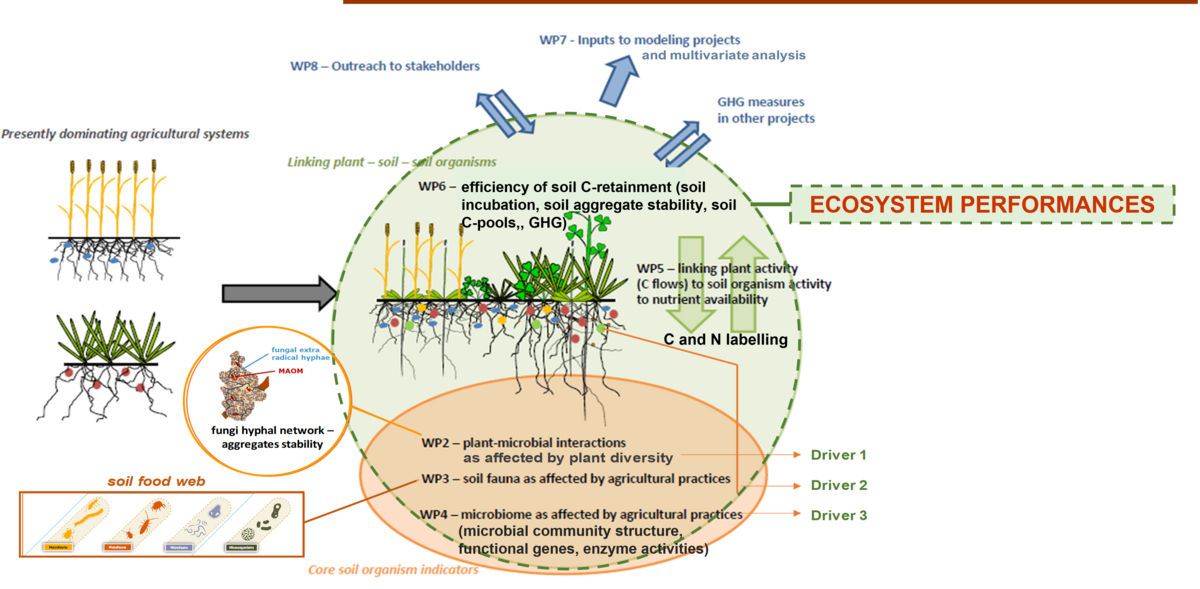AGROECOSeqC
| Start: | 1 November 2021 |
| Duration: | 36 Months |
| Aim: | By studying the main actors involved in main biogeochemical processes, AGROECOseqC challenge is to investigate the underlying mechanisms promoting the synchrony between plant demand and nutrient supply by soil microbiome, with the aim to build sustainable agricultural systems where plant, soil fauna and microbial diversity are key drivers to reduce nutrient losses, GHG emission, and increase C sequestration in soil. |
| Keywords: | Plant diversity, soil fauna, soil microbiome diversity, plant-soil biota interaction, plant demand-microbial supply synchrony, soil carbon and nutrient fluxes, carbon : nutrient coupling, SOC storage, GHG emission |
| Contact: | Project coordinator: Alessandra Trinchera (alessandra.trinchera@crea.gov.it) Project co-coordinator: Sebastien Fontaine (sebastien.fontaine@inrae.fr) Project communication representative: Valentina Baratella (valentina.baratella@crea.gov.it) |
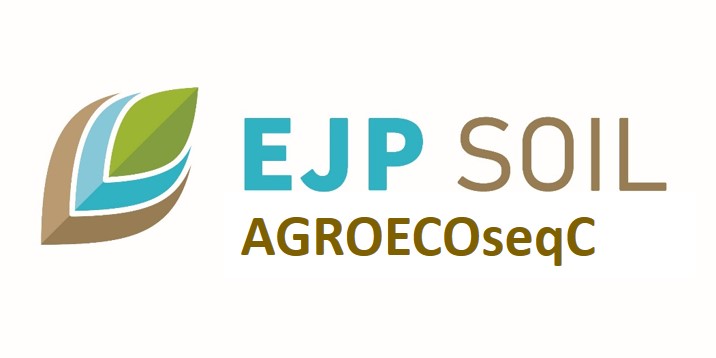
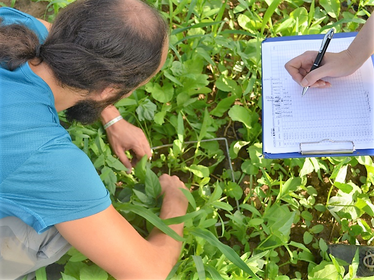
Soil fauna and microbial communities drive key ecosystem functions, such as nutrient supply to primary production and SOC accumulation. However, plant diversity shapes soil biota composition and activity via rhizodeposition and N-P uptake, microbial symbioses, and trophic cascades. In EU experimental sites network, the project will study how agroecological intensification of cropping systems (e.g. introduction of plant services) can allow better regulation of degradation/resynthesis of soil organic matter and nutrient cycling by the plant-soil system. Advantages and disadvantages of such agroecological systems will be compared to less conservative ones for plant-soil fauna microbial functional diversity, biomass production, N leaching, soil C-stable pools, GHG emission and C sequestration.
AGROECOseqC project goals will be:
- Quantify the impact of agricultural practices on ecosystem services, including biomass production, SOC storage, greenhouse gas emission and nutrient retention;
- Analyse the role played by plant diversity and specific traits on soil fauna and microbial community diversity and functioning, as relevant drivers for SOC storage in soil; particular interest will be put on the fungal mycelial network development in soil and its function at increasing soil aggregates stability;
- Assess the level of synchrony between plant nutrient demand, nutrient supply from soil biota and decomposition/resynthesis of soil organic matter along the gradient of tested agroecological management practices;
- Identify the most sensitive and robust indicators able to describe the agroecosystem, and how the considered agroecological practice can shape plant community, soil meso- and microfauna, soil microbial community and functioning in favour of C persistence in soil;
- Integrate microbial functional diversity and rhizosphere plant-soil interactions (soil fauna, rhizosphere priming, plant control of SOM dynamics, symbiotic associations) into a model of ecosystem C and N cycling (SYMPHONY);
- Contribute to integrate these variables in other models considered by other current EJPSoil projects (SOMMIT, CarboSeq, others), also comparing different models’ performances on the dataset produced by the project.
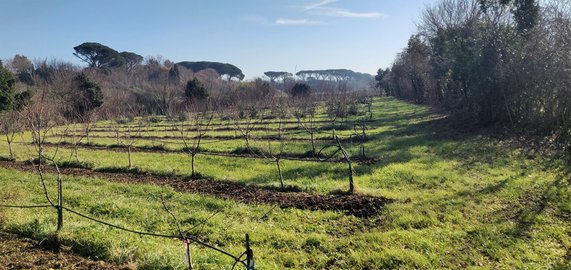
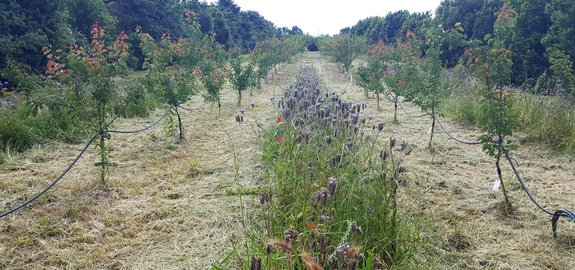
Work packages
WP 1: Project management and coordination
WP Leader: Alessandra Trinchera (CREA)
WP deputy: Sebastien Fontaine (INRAE)
The WP1 will organize all the experimental actions from in-field soil/plant/fauna sampling to laboratory analyses, guaranteeing the proper flux of information (applied methodologies, common protocols, identification of constraints and corrective actions, etc.). The coordination action will assure that project results will be transferred to WP7 involved in data elaboration and will strictly work with WP8 to promote communication and dissemination of obtained results. The coordinators will promote the constant relationship with MIX ROOT, MAX ROOT, Carboseq, SOMMIT projects coordinators, whose representatives are involved as participants in AGROECOseqC project.
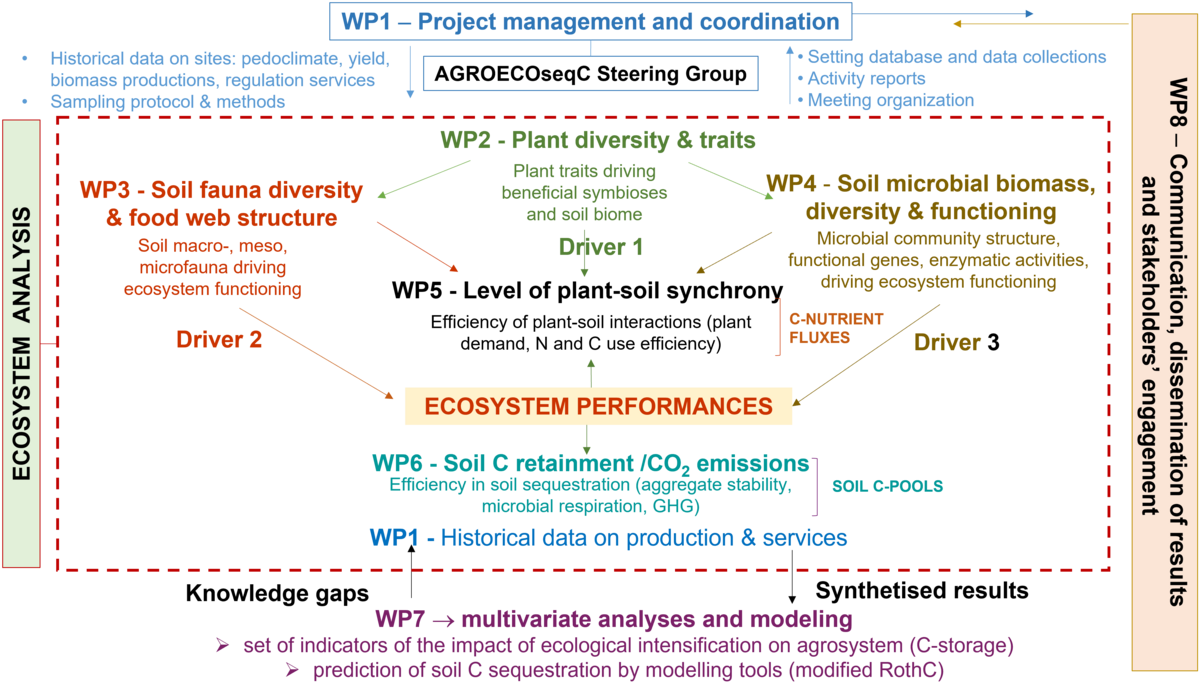
WP 2: Plant communities and rhizosphere plant-microbe interactions
WP Leader: Elena Testani (CREA )
WP deputy: Akin Un (TAGEM)
The overall objective of WP2 is to evaluate how an ecological intensification perspective in managing soil and agrobiodiversity in agroecosystems can drive soil C sequestration through affecting plant community traits, among those related to C-input and C storage (particularly the supporting arbuscular mycorrhizal plant trait) across different European pedo-climatic conditions. Clear indicators of the carbon storage potential of the systems under agroecological management, driven by plant communities and rhizosphere plant-microbe interactions, will be developed to merge towards WP7 multivariate analysis.
WP 3: Soil macro- meso- and microfauna functional diversity
WP Leader: Sara Sánchez-Moreno (CSIC-INIA)
WP deputy: Joaquin Cobos (CSIC-EBD)
The overall objective of WP3 is to quantify the role of soil fauna as one of the main drivers of C stability and sequestration in agricultural soils across varying edaphoclimatic conditions in Europe. Current evidence suggest that soil organisms play fundamental roles in nutrient cycling and soil functioning through both bottom-up and top-down forces. However, few studies have addressed the impact of the whole soil food web in C sequestration. In this WP, we will be able to integrate information on micro- meso- and macrofauna to quantify the role of soil fauna as drivers of C sequestration
WP 4: Soil microbial functional diversity
WP Leader: Marga Ros (CEBAS-CSIC)
WP deputy: Luisa Maria Manici (CREA)
The main objective of WP4 is to provide a scientific understanding about the behaviour of soil microbial communities (bacteria and fungi) involved in biogeochemical cycles, SOC mineralization and stabilization in agricultural soils under different sustainable management practices and pedoclimatic conditions. Soil microbial community shapes soil structure and associates with plant species promoting growth and development under the different agro-ecological practices applied in the project, based on diversification and conservative soil management. We intend to identify the major drivers of SOC sequestration, and the functional complexity involved in C persistence linked to soil microbial community diversity and functioning, to use them in suitable programs of land investment and use.
WP 5: Level of synchrony between plant nutrient demand, soil nutrient fluxes and soil organic matter dynamics
WP Leader: Sebastièn Fontaine (INRAE)
WP deputy: Jim Rasmussen (AU)
The main objectives of the WP are to evaluate the impact of agricultural practices on the 1) intensity of nutrient and carbon fluxes generated by microbial decomposition and resynthesis of soil organic matter (SOM), and 2) the level of synchrony between the nutrient supply from soil biota and the plant nutrient demand which fluctuates with time. The findings of the WP will determine whether the proposed agroecological practices enable the restoration of the two key functions of natural soils: supplying plants with soluble nutrients during plant growing periods and resynthesis of SOM storing nutrients and carbon during dormant periods.
WP 6: Soil C retainment through stable aggregates and microbial biomass activity
WP Leader: Flavio Fornasier (CREA)
WP deputy: Skaidre Suproniene (LAMMC)
The overall objective of the WP6 is to evaluate the impact of agricultural practices on chemical and physical stabilization of soil organic matter and microbial activity during the stationary and active growth phases in order to identify the relevant indicators for modelling of soil C dynamic.
WP 7: Multivariate analysis and Modelling soil organic matter dynamics
WP Leader: Raphaël Martin (INRAE)
WP deputy: Marjoleine Hanegraaf (WR)
The aim of this WP is to assess how agroecological practices may affect soil diversity and functioning, considering all the components influencing it, from plant diversity and traits to soil fauna and soil microbiota, evaluating the supplied ecological services, as organic matter decomposition, nutrient cycling, primary production, or GHG fluxes.
Assessing the relative impact of the soil biome on the formation and persistence of SOC is the overall objective of this WP. Our hypothesis is that the soil biome and its interaction with plant roots have significant and substantial impact on SOC-persistence. Based on identification of robust microbial indicators of key processes in the C cycle using multivariate approach and after the development of some toy models to test the effectiveness of new process implementation, a mechanistic model will be formulated on the relationships between the soil biome and SOC dynamics. This will be used as reference for improving classical and/or next generation models. Scenario-analysis from LTE-data will deliver estimates of the effect of the soil biome on carbon sequestration and persistence in agro-ecosystems in Europe depending on crop covers and agricultural practices (conventional -> agroecological).
WP 8: Communication, dissemination of results and stakeholders’ engagement
WP Leader: Valentina Baratella (CREA)
WP deputy: Marga Ros (CEBAS-CSIC)
The WP 8 is responsible for Communication, Dissemination and Exploitation activities (CDEs) of AGROECOseqC, with the aim of raising awareness on the role of Agroecological Management Strategies in optimizing resource use and increasing SOC storage in different EU pedoclimatic contexts. Research progress and results will be made accessible to diverse end-users’ groups across Europe at various levels of participation, which will clustered in four broad groups: farmers & advisors (including associations), civil society & general public, the scientific community, and policy makers. The EJPSOIL NCRs, which will be the key link to end-users across Europe, and the existing networks of stakeholders built on previous research projects will help establish the connections and enable a self-standing interaction. In order to ensure contact and engagement of farmers and consultants, all countries of AGROECOseqC will organize at least one national workshop in conjunction with field days and will spread all relevant findings achieved during project activities also via websites, social media and factsheets. By effectively sharing the knowledge gained on plant-soil biota interactions and functionality, AGROECOSeqC intends to facilitate the developing of suitable programs for land use, increasing the long-term sustainability of European agriculture.
AGROECOseqC Scientific Advisory Board
The SAB will provide executive leadership to successfully run the project from the scientific point of view, supporting the project coordinators.
Articles about results from AGROECOSeqC:
- Fontaine, S., Abbadie, L., Aubert, M.,Barot, S., Bloor, J. M. G., Derrien, D., Duchene, O., Gross, N.,Henneron, L., Le Roux, X., Loeuille, N., Michel, J., Recous, S.,Wipf, D., & Alvarez, G. 2023. Plant–soil synchrony innutrient cycles: Learning from ecosystems to designsustainable agrosystems. Global Change Biology, 30, e17034.
- Trinchera, A.; Warren Raffa, D. Weeds: An Insidious Enemy or a Tool to Boost Mycorrhization in Cropping Systems? Microorganisms 2023, 11, 334.

